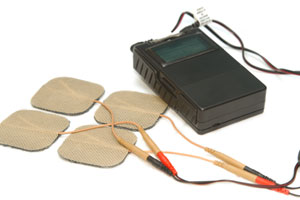by Micke A. Brown, BSN, RN
What is TENS?
 TENS is considered a form of “electroanalgesia” which helps decrease pain without the use of needle placement or surgical implant. It is designed interrupt pain signals in the body by competing with them. A TENS unit consists of a battery operated (usually 9 volt) device that can be easily worn on a belt, waistband or placed in a pocket of clothing with leads (wiring) and lead pads (adhesive patches). Percutaneous Electrical Nerve Stimulation (PENS) is different as it uses acupuncture-like needle placement as leads. This is also referred to as electroacupuncture.
TENS is considered a form of “electroanalgesia” which helps decrease pain without the use of needle placement or surgical implant. It is designed interrupt pain signals in the body by competing with them. A TENS unit consists of a battery operated (usually 9 volt) device that can be easily worn on a belt, waistband or placed in a pocket of clothing with leads (wiring) and lead pads (adhesive patches). Percutaneous Electrical Nerve Stimulation (PENS) is different as it uses acupuncture-like needle placement as leads. This is also referred to as electroacupuncture.
TENS can be used in the treatment of acute and chronic pain, including inflammatory pain from surgery, arthritics, neuropathic pain conditions (CRPS/RSD, fibromyalgia, neurogenic bladder) and muscles (muscles strains, sprains, low back pain). March 2014, the FDA approved the first TENS device for use in migraine headaches.
They are commonly managed by physical therapists (Acupuncturists for PENS), however, a prescription may be given by your health care provider for a medical supply store or pharmacy to dispense. TENS units are very safe, and not hurtful to apply or wear as long as they are used properly. Ideally instructions of how to use and a TENS trial should be offered by a knowledgeable clinician. Some insurance companies require this process while others may deny claims for PT or clinical instruction and TENS trials. This factor may contribute to TENS failure rates. Notably, in 2012, the Centers for Medicare and Medicaid Services (CMS), changed its coverage of TENS for the use in low back pain with limits to only those participating in clinical trials through 2015 as “currently, no clinical studies involving TENS for the treatment of CLBP have been approved by CMS.”
There are different models that may offer a variety of ways the stimulus is delivered, such as constant vibration vs. pulse vs acupuncture-like. Lead placement can be shown in different patterns, too. Lead pads can be placed on each side of the spine where the pain signals enter via the nerve roots (Dermatomal), surround the area of pain or crisscross the pain affected area. 10 tips for TENS placement provides pad placement guidelines for muscular pain of the low back, knee, upper arm, ankle & foot.
The sensation should feel comfortable or pleasurable when the unit is turned on. A TENS unit will NOT electrocute you, however you can prevent an unintentional “shock” by not wearing it the shower, bath tub, hot tub or when swimming. Also avoid turning it up too high. It is not recommended to be used with a (demand-type) cardiac pacemaker; leads should not be placed on the front of the neck where the larger blood vessels (carotid arteries) are located.
Is there a recommended time to turn on your TENS unit?
Yes, when:
- You are most active
- Your pain is the most bothersome
- You are engaged in an activity that tends to aggravate your pain.
Try to prevent having it turned on all or most of the time. That puts you at risk for getting accustomed to the signals; it may seem like your TENS is not working as well as before. That can be due to either the development of “signal tolerance” or your pain condition may have become worse.
How effective is TENS?
Clinical effectiveness of TENS is controversial, with some studies supporting whereas others refute its clinical use. There has been a need for greater numbers of high quality, randomized, controlled clinical trials. One study showed that PENS was more effective than TENS in providing short-term pain relief and improved functionality in patients with sciatica. This was reinforced by another study which concluded its effectiveness for low back pain.
Recently, (2005 to current) more clinical trials are showing that adequate dosing, particularly intensity, is critical to obtaining pain relief with TENS. The evidence continues to emerge from both basic science and clinical trials which support the use of TENS for the treatment of a variety of painful conditions. Research is also beginning to identify strategies that aid in improving TENS effectiveness.
